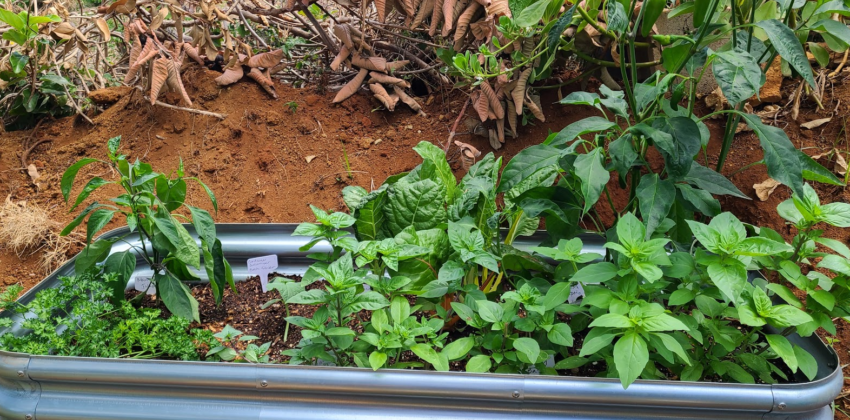Check out this post from Oregon State University (OSU), “Things to consider when starting your vegetable garden.” It’s probably the best checklist I’ve seen so far: short and actionable for those interested in getting into food sustainability.
Here’s a picture of my seven square foot raised bed. Right now I have about 10 basil plants, 5 jalapeno plants, a container bush cucumber, 5 swiss chard and an American parsley growing in it. The plants are relatively young, so it will be interesting to see if they get crowded out. So far, it looks like the plants fit fine.
Among the important points OSU makes, is that you should start small and gardening a small plot of land doesn’t have to take a lot of time or effort. “OSU researchers estimate 100-square-foot garden requires 40 minutes per week for planting and cultivation and 30 minutes for each watering session.” I think 30 minutes for each watering session is a bit on the high side myself. There are a number of really good techniques and products that can bring that number down to practically nothing. A timer and drip irrigation could essentially make that watering time number nearly zero. All you would need to do is plant, weed and pick for less than an hour a week. You would, of course, need to plan and lay your water lines but that’s pretty much a one time planning event and occasional tweak.
As far as what to plant? Here in Hawaii, I’d recommend some of our “forever” crops. They’re not really forever, but unlike on the mainland we don’t have to contend with frost so they do produce for long periods of time. Crops on my short list are: peppers (sweet or hot), American or Italian parsley, okra, and Swiss chard and Basil — especially Thai basil which seems more durable than the Italian types, which need to be trimmed regularly to prevent going to seed. These choices are pretty much a plant once, enjoy for a year or two. If you think about how much parsley or Swiss chard costs at the grocery, you can see how valuable your one time purchase of a seedling is in comparison.
There are a few vegetables that others may wonder why didn’t make the beginner’s list for me. Even if some tomatoes are indeterminate, I only seem to get a round or so before the plant shrivels up. The one time I had luck with tomatoes it was in a container that was constantly fed with high density manure and nutrients. Tomatoes, like eggplant and cucumbers, love being fed nutrient rich mulch or fertilizer. I’d make an exception for growing cherry tomatoes, which I think is a good easy substitute for larger fruit. It isn’t quite as nutrient demanding or fussy. On the other hand, our friend G seems to do well with his tomatoes. I believe he raises them in a greenhouse with hydroponic flow, however.
I also left off the “3-D” plants, the ones that need trellising and support. Tomatoes fall into this category, but so do other types of plants like climbing bean vines, squash and cucumbers.
In addition to the “forever” crops, you can also plant a patch of short-season crops like lettuce or leaf amaranth which is quickly satisfying and quickly harvested.
